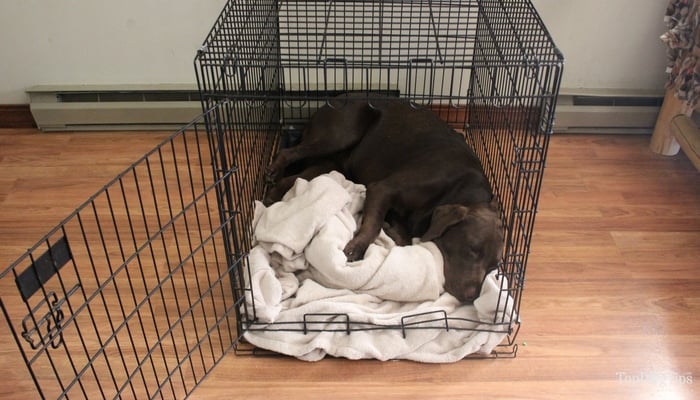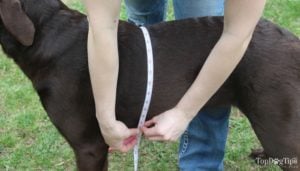Crate training a dog is an important part of house training. To begin with, you'll need to buy a dog crate that would fit your pet, and dog crate sizes are much more important in the training process than you realize.
You might be asking yourself:
Well, what size crate for my dog should I get?
Below is everything you should know about this topic using our dog crate sizes chart.
We will teach you how to size a dog crate to buy a perfect fit for your pup.
The surest way to find the correct dog crate size is by measuring your dog first (see below).
You can use a general guideline for dog crate sizes by breed and weight of the dog, but remember that these are only arbitrary manufacturer standards, and depending on who made the crate, they may differ a little.
Note: While the below dog crate size chart includes a dog's weight, the actual size and measurements (length, width, height) of your dog are far more important than weight.
For the best results, measure your pet before picking the dog kennel size.
Dog Crate Sizes Chart
| Dog's Weight | Dog Crate Size | Dog Crate Sizes by Breed |
| Under 30 pounds | 18″ x 18″ 18″ x 24″ (Extra Small)» Extra Small Crate Examples |
Chihuahua (and similar) |
| Under 38 pounds | 24″ x 18″ 24″ x 24″ (Small)» Small Crate Examples |
Affenpinscher, Cairn Terrier, Havanese, Japanese Chin, Maltese, Norfolk Terrier, Pekingese, Pomeranian, Scottish Terrier, Shih Tzu, Skye Terrier, Silky Terrier, Toy Poodle, Toy Fox Terrier, West Highland White Terrier, Yorkshire Terrier |
| Under 40 pounds | 24″ x 30″ 24″ x 36″ (Small+)» Small Crate Examples |
Cocker Spaniel, Australian Terrier, Basset Hound, Bichon Frise, Boston Terrier, French Bulldog, Bull Terrier, Cardigan Welsh Corgi, Dachshund, Italian Greyhound, Jack Russell Terrier, Lhasa Apso, Poodle, Schnauzer, Parson Russell Terrier, Wirehaired Fox Terrier |
| 40 to 60 pounds | 30″ x 24″ 30″ x 30″ 30″ x 36″ (Medium)» Medium Crate Examples |
American Eskimo Dog, American Staffordshire Terrier, Basenji, Beagle, Brittany Spaniel, Chinese Sharpei, Chow Chow, German Pinscher, Irish Terrier, Keeshond, Kerry Blue Terrier |
| 50 to 80 pounds | 36″ x 24″ 36″ x 30″ 36″ x 36″ (Medium+)» Medium Crate Examples |
American Pit Bull Terrier, Australian Cattle Dog, Border Collie, Bull Terrier, Dalmatian, Old English Sheepdog |
| 80 to 100 pounds | 42″ x 30″ 42″ x 36″ (Large)» Large Crate Examples |
Airedale Terrier, Alaskan Malamute, American Bulldog, Boxer, Briard, Malinois, Tervueren |
| 90 to 100 pounds | 48″ x 24″ 48″ x 30″ (Extra Large)» Extra Large Crate Examples |
Airedale Terrier, Alaskan Malamute, Boxer, Briard, Dalmatian, Malinois, Tervueren |
| Approx. 100 pounds | 48″ x 36″ (Extra Large+)» Extra Large Crate Examples |
Afghan, Akita, Bloodhound, Borzoi, Chinook, Doberman Pinscher, German Shepherd, Gordon Setter, Greyhound, Irish Setter, Leonberger, Neopolitan Mastiff, Newfoundland, Pointer, Rottweiler, Siberian Husky, Standard Poodle, Weimaraner |
| 100 to 180 pounds | 60″ x 36″ 72″ x 36″ (XXL)» XXL Crate Examples |
Akita, Anatolian Shepherd Dog, Bernese Mountain Dog, Bullmastiff, Great Dane, Great Pyrenees, Irish Wolfhound, Leonberger, Mastiff, Newfoundland, Scottish Deerhound, Siberian Husky |
* For best results, use the above dog crate size chart alongside your dog's measurements.
Dog Crate Sizes: Tips on How to Size a Dog Crate
1. Plan for the Future
First, you need to decide on the type of dog crate and who's going to use it.
Is your dog full grown? If you're planning on crate training a puppy, you're going to need to buy a dog crate that your pup won't grow out of in 3 months.
You need a pet crate that “grows with your dog.”
There are many different types of crates that are designed to “grow with your dog.”
As I explain in my above video on how to size a dog crate, these kennels will come with a divider, which is key.
You can position the divider to create the right size crate for your young dog, and then remove the divider to offer your adult dog plenty of room when he's fully grown.
2. Measure Your Dog for the Crate
Many dog crates are returned after the purchase because the owner didn't pick the right size and they likely only used the dog crate size chart or the grouping of dog crate sizes by breed.
Don't make the mistake of relying on those charts alone.
You absolutely need to measure your dog for the crate.
Knowing your dog's height, width, and length at the time of crate purchase is the only way to find a perfect fit.
Remember that the above dog crate size chart is only a very rough estimate of what may be an appropriate size, and the same applies to the dog crate sizes by breed chart.
Why are accurate dog crate sizes and dog's measurements that important?
A dog crate that is too small will confine your pet and make them uncomfortable.
This will cause him to dislike his pet crate, and it's likely that you'll have trouble getting him to climb into the cage willingly when you need him to.
Crate training won't work either.
A dog crate that is too large will cause problems as well.
If your dog is not house trained, he may be able to use the bathroom in one corner of the crate and sleep in another.
This will hinder the house training process, and it will also be quite an annoyance for you to clean the pet crate every day.
If you have a puppy, you'll need to estimate the full-grown size of your dog. It'll take some effort on your part.
For example, do you have a friend of the same breed?
Do some research online to find the average breed height and length of your pup.
There are some measuring guidelines to follow that you can use alongside a dog crate sizes chart.
Here are a few most important considerations:
- Measuring to find the right length: You'll need to measure the length of your dog from the tip of his nose to the end of his tail. Now, add 2″ to that measurement if you have a small/medium breed and 4″ if you have a large/extra large breed. This is the length of the crate that you will need. It will allow your Fido enough space to turn around comfortably.
- Measuring to find the right height: You'll need to measure your pet's height from the floor to the top of his head if he has floppy ears. If he has erect ears, you'll need to measure from the floor to the tip of his ears. Now add 1″. This is the height of the crate that your dog needs.
- Measuring to find the right width: Measure the widest point across your pet's chest. Now add 4″. This is the correct width for the crate that your dog will need.
 3. Choose a Slightly Larger Dog Crate Size
3. Choose a Slightly Larger Dog Crate Size
You will probably not find a dog crate that fits the exact length, width and height of your dog.
Just try to stay as close to those measurements as possible.
When in doubt, go with a bigger length, width or height than you need.
Whether you're picking a soft dog crate, a plastic one, or a metal dog crate, the exact dog crate sizes do matter.
An extra inch or two won't be a big deal, but if you take an inch or two of needed space away, your dog may not be comfortable and there's no “wiggle room” in that case.
For example, let's say your dog is 14 inches long.
He's a small breed, so you will need to bump that measurement up to 16 inches. If you find a dog crate size of 17″ in length, that's totally okay.
When choosing the most appropriate dog crate sizes, it's important that your pet's comfort is the first priority.
An extra inch or two won't give your pup enough space to defecate in the pet crate and get away from it.
However, if you take an inch or two off the amount of space that he needs to be comfortable, it could result in your pooch not being able to turn around or lie down comfortably in the crate.
Make sure you watch the video on how to size a dog crate above for the full explanation, and if you have any questions on choosing the right size dog crate or finding the best dog crate for your pooch, feel free to leave those in the comments down below.
READ NEXT: 11 Tips on How to Use Dog Crates Safely
Disclosure: We may earn affiliate commissions at no cost to you from the links on this page. This did not affect our assessment of products. Read more here and find full disclosure here.
















